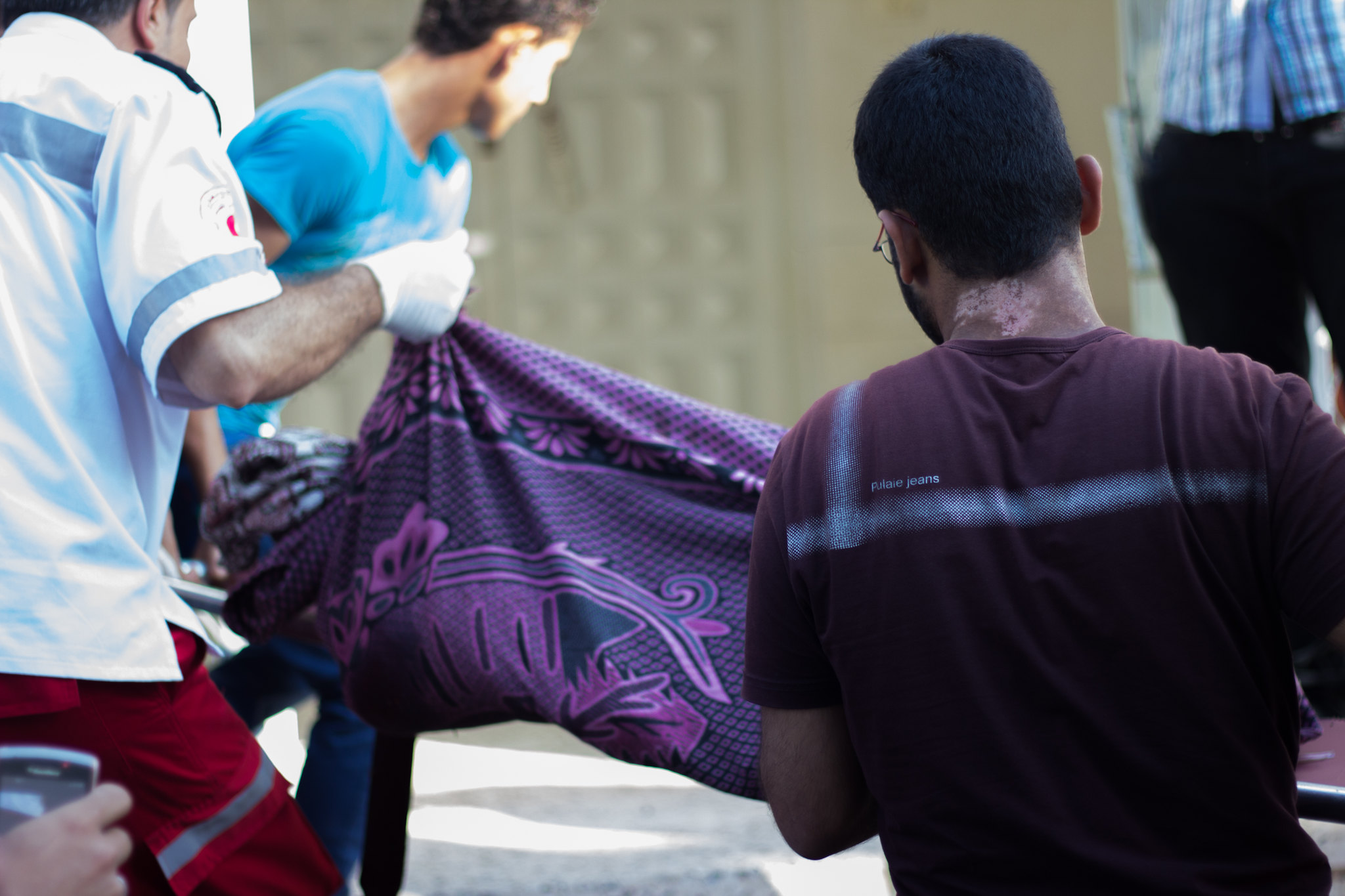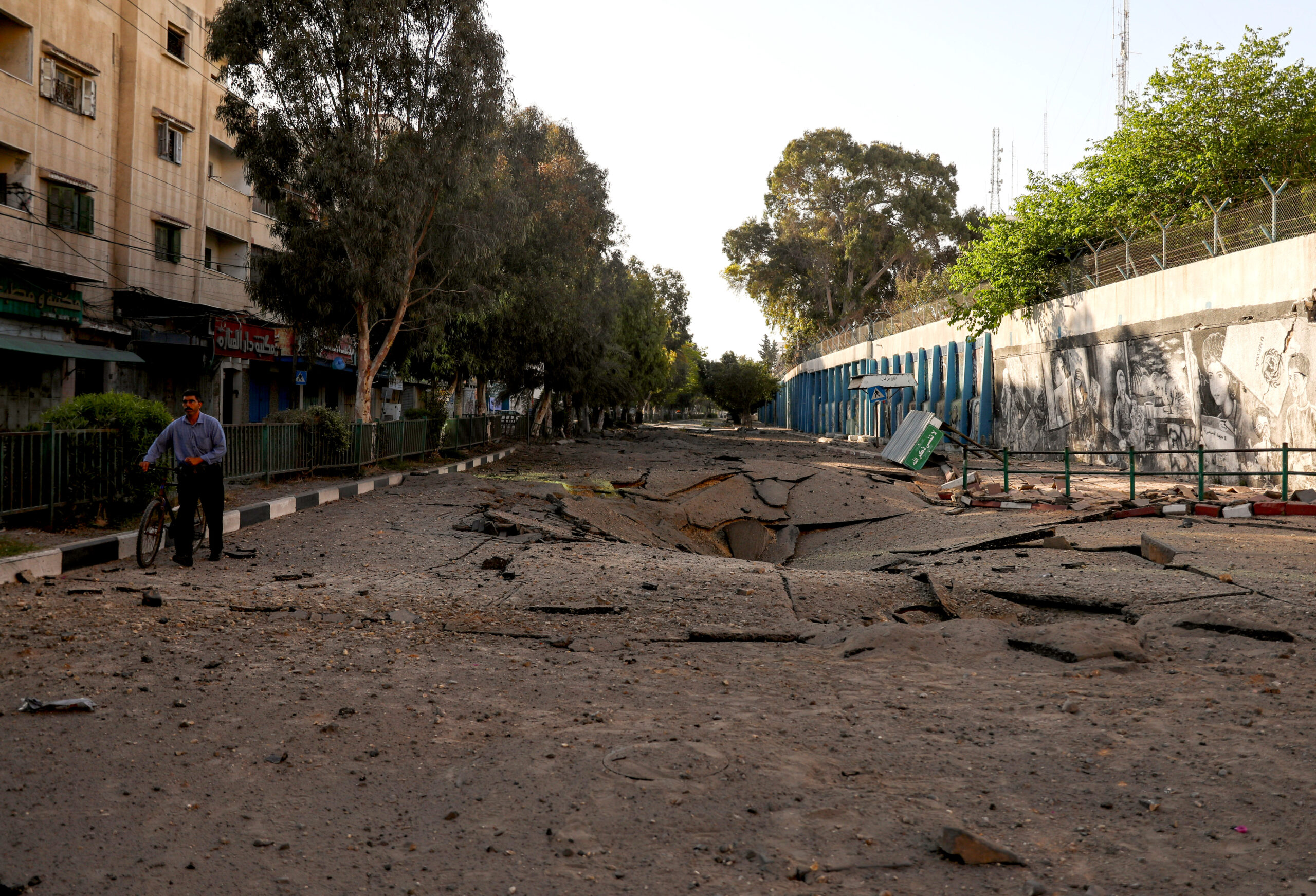“This needs the right intervention, an intervention from the outside world.” Ann Wright reports on an open letter from the director general of the Gaza Community Mental Health Programme.

Gaza crisis 2014. (Charity Organisation, Flickr, CC BY 2.0)
 Dr. Yasser Abu Jamei, the director general of the Gaza Community Mental Health Programme has written a powerful letter to the world about the physical and mental effects of the deadly and horrific Israeli bombing of Gaza.
Dr. Yasser Abu Jamei, the director general of the Gaza Community Mental Health Programme has written a powerful letter to the world about the physical and mental effects of the deadly and horrific Israeli bombing of Gaza.
Twelve years ago in January 2009 Medea Benjamin, Tighe Barry and I got into Gaza days after the 22 day Israeli attack on Gaza ended with 1,400 Palestinians killed, including 300 children, and hundreds of other unarmed civilians, including more than 115 women and some 85 men aged over 50 during Israeli military attack named “Cast Lead” and visited Al Shifa Hospital to hear the stories of doctors, nurses and survivors to write articles to mobilize support for Gaza.
In 2012 we again went to Al Shifa Hospital, the one that Dr. Abu Jamei speaks of in his letter, after the five-day Israeli attack to bring a check to help with medical supplies for the hospital.
The father of a 12-year-old girl killed in an Israeli airstrike holds her body at al-Shifa hospital @AFP pic.twitter.com/2AN52W5m4F
— Randa HABIB (@RandaHabib) May 18, 2021
Accounts of the brutal injuries done to citizens of Gaza by the indiscriminate Israeli attacks in 2009, 2012 and 2014 have been described in articles in 2012 and 2014.
Here is Dr. Yasser Abu Jamei’s May 16 letter:
“After Saturday’s bombing raids in the heart of Gaza City killing at least 43 people including 10 children and 16 women, Gazans are once again struggling with traumatic memories. The atrocities that are happening now bring memories. Israeli planes have shattered our families so many terrifying and memorable times for decades. For instance, over and over again for three weeks during Cast Lead in December 2008 and January 2009; seven weeks in July and August 2014.
Collapsed buildings’ blocks and gaping holes in Alwehdah Street where there was normal life a week ago are traumatic sights, triggering memories of those earlier atrocities.
A crater left by Israeli air raids in one of the main streets of Gaza City, May 12. (M. Hajjar/NRC)
Today there are hundreds of injured people to be cared for in our crowded hospitals which are desperately short of many supplies because of the years of Israeli siege. Huge efforts are ongoing by the community to search for people under the wreckage of the buildings.
Among the people who were killed: Dr Moen Al-Aloul, a retired psychiatrist who treated thousands of Gazans at the Ministry of Health; Mrs Raja’ Abu-Alouf a devoted psychologist who was killed together with her husband and children; Dr Ayman Abu Al-Ouf, with his wife and two children, an internal medicine consultant who was leading the team treating patients with COVID at Shifa hospital.
Memories of every previous trauma are impossible to forget because all of us in Gaza always live lacking a sense of safety. The Israeli drones have never left the sky over us between 2014 and 2021. Shelling continued to happen during random nights. Although the shelling was infrequent, it was enough every time to remind us all of what we have been exposed to and will be again.
The weekend’s attack took place without any warning. It’s yet another massacre. Just an evening earlier ten people were killed including eight children and two women. One family of seven was wiped out except for just the father and a three month old baby. The father lived because he was not at home, and the baby was saved after being found under the wreckage, protected by his mother’s body.
These are not new scenes for Gazans, unfortunately. This is something that keeps happening throughout these offensives. During the 2014 offensive it was reported that 80 families were killed with no one left alive, just removing them from the records. In 2014 in one single attack, Israel destroyed a three story building that belong to my extended family, killing 27 people including 17 children and three pregnant women. Four families were simply not there anymore. A father, and a four year old son were the only survivors.
Now the news and fears of a possible land invasion are overwhelming us with yet other devastating memories as we confront each new horror.
One barbaric attack has included 160 jetfighters attacking for over 40 minutes in the very northern areas of the Gaza Strip, accompanied by artillery shelling (500 shells) that hit the eastern side of Gaza City and northern areas. Many houses were destroyed, though most of the people were able to escape from their homes. It is estimated that as many as 40,000 people have headed yet again to UNRWA schools or to relatives, seeking shelter.
Displaced Palestinians gather at a UN school in the northern Gaza Strip after fleeing their homes in an area under heavy Israeli aerial bombardment in the besieged Palestinian territory, Aug. 26, 2014.
(UN Photo/Shareef Sarhan)To most Gazans, this is a reminder of the first attack in 2008. It was Saturday 11.22 am when 60 jetfighters started bombing the Gaza Strip terrorizing everyone. At that moment, most school children were in the streets either returning from the morning shift or going to the afternoon shift. While children started running, terrified, in the streets, their parents at home were distraught not knowing what had happened to their children.
Families being displaced now is a painful reminder of the huge displacement of 2014 when 500,000 people were internally displaced. And when the ceasefire came, 108,000 could not return to their destroyed homes.
People have now to deal with triggers to all these previous traumatic events, and more. This makes natural healing processes more complicated and in some cases it causes a relapse of symptoms. We always try to explain that Gazans are not in a post-traumatic condition, but in an ongoing condition that needs deeper attention.
This needs the right intervention. It is not clinical, but moral and political intervention. An intervention from the outside world. An intervention that ends the root of the problem. One that ends the occupation, and gives us our human right to a normal family life rooted in the feeling of safety no child or family in Gaza knows.
Many people in our community have been calling us in the clinic from day one. Some were people working in hospitals, or in the NGO sector. Some appealed through our Facebook page asking about GCMHP services as they see traumatized people on every side, and feel a desperate need for our services.
Our staff are part of the community. Some of them had to leave their homes. They need to feel safety and be secure in order to help others. But still, without that safety they are still devoted to the organization and to the community. They feel a great responsibility for their vital role supporting the psychological wellbeing of Gazans. They are totally and tirelessly available.
Over the weekend we made public the mobile numbers of most of our technical staff. On Sunday our toll free line resumed operating, and from 8 am to 8 pm it will be ringing these days. Our FB page started to raise awareness for parents on how to help deal with children and stress. It is true that we have not had the chance to prepare new material, but our library is a very rich one with our products and it’s time to harvest the wisdom and support in our YouTube library. Perhaps this is not our best intervention, but definitely it is the most that we can do in these circumstances to provide Gazans with strength and skills in coping inside their terrified families.
As of Sunday evening, 197 people have already been killed, including 58 children, 34 women, 15 elderly people and 1,235 are injured. As a psychiatrist I can say that the invisible psychological toll on everyone from the youngest to the oldest is acute – from fear and stress.
It is a moral imperative for the world to look straight at us, see us, and commit to intervention to save Gazans’ valuable creative lives by giving them the sense of safety every human needs.”
Israeli strikes damaged at least three hospitals in Gaza, as well as a clinic run by Doctors Without Borders. A number of doctors have also been killed in the Israeli airstrikes, including Dr. Ayman Abu al-Ouf, who headed the coronavirus response at Al Shifa, Gaza’s largest hospital. He and two of his teenage children died in an Israel airstrike on their home. Another prominent doctor from Al Shifa Hospital, the neurologist Mooein Ahmad al-Aloul, was also killed in an airstrike on his home. The Palestinian Center for Human Rights said the Israeli airstrikes have erased entire residential neighborhoods and left earthquake-like destruction.
“You see all of this? What do you expect me to do? Fix it? I’m only 10”
– a ten year old girl from #Gaza after Israeli strikes.pic.twitter.com/jDQPGoWOHf
— Sara Firth (@Sara__Firth) May 16, 2021
According to Democracy Now, on Sunday, May 16, Israel killed at least 42 Palestinians in Gaza in the deadliest day so far as Israel bombarded the besieged area with airstrikes, artillery fire and gunboat shelling. Over the past week, Israel has killed nearly 200 Palestinians (as of Monday morning reporting), including 58 children and 34 women. Israel has also destroyed over 500 homes in Gaza, leaving 40,000 Palestinians homeless in Gaza. Meanwhile, Israeli security forces and Jewish settlers killed at least 11 Palestinians in the West Bank Friday in the deadliest day there since 2002. Hamas is continuing to fire rockets into Israel, where the death toll has reached 11, including two children. One Israeli airstrike on a Gaza refugee camp killed 10 members of the same extended family, including eight children.
Ann Wright is a retired US Army Colonel and a former U.S. diplomat who resigned in 2003 in opposition to the US war on Iraq. She has been to Gaza many times and has participated in voyages of the Gaza Freedom Flotilla to break the illegal Israeli naval blockade of Gaza.
This article is from OpEdNews.com.
Please Support Our
Spring Fund Drive!





Bequest
Look to your own house, O, Yisroel!
Your children sharpen their teeth
in red rage, maniacally
embrace your cauldron of hate.
Their scorched hearts
crumble to cinders.
This you bequeath.
Let no one lay stone
or desiccated wreath
to such contagion,
devoid of compassion.